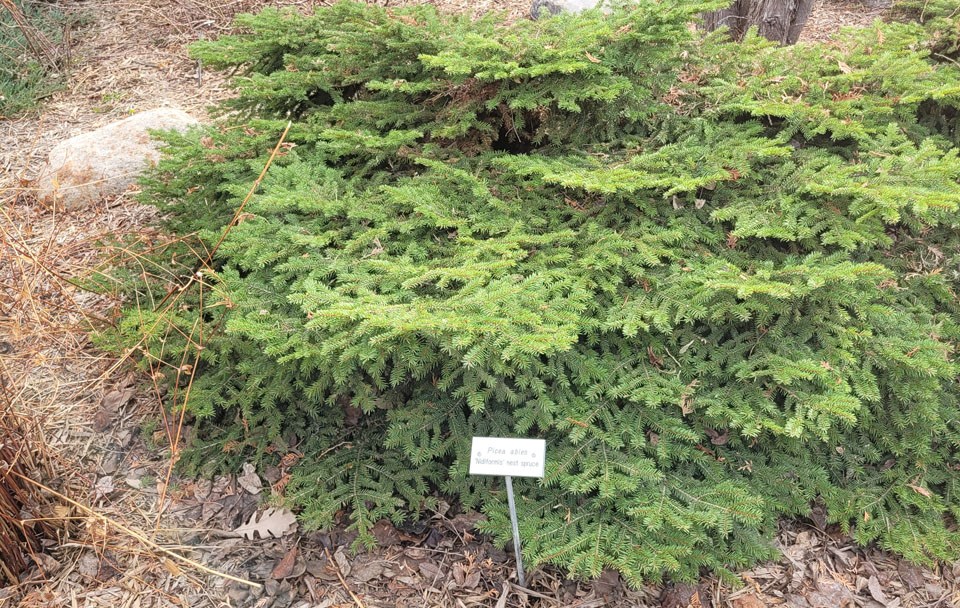Let’s begin with some definitions. A “mixed border” consists mainly of herbaceous perennials (those that die back to ground level each winter) but may also include hardy and tender bulbs, annuals, biennials, vines, and coniferous and deciduous shrubs. Together, these plants give the border greater interest with their different heights, textures, and colours, and an extended season that perennials alone could seldom accomplish.
“Dwarf conifers” generally range in height from 0.3 m (12 in.) up to 2 m (6 ft.), but even at their largest remain considerably smaller than their “normal” cousins. They vary in size, colour, form and texture; give a certain weight and substance to the border through spring, summer and fall; and extend their interest into winter (assuming that they are not buried in snow.) They generally require less maintenance than perennials, and as I become older, this feature assumes greater value. The following have proved hardy in my zone 2b garden. Most have been selected for their limited spread as well as height; they are not “groundcovers” that will continue indefinitely. Some may eventually (after 40 years) become larger, but that is generally a problem for “the next owner.”
- Dwarf balsam fir (Abies balsamea ‘Nana’) – (0.6 x 1. m/2 x 3 ft..) is attractive, densely branched, deep green and globular.
- ‘Mother Load’ juniper (Juniperus horizontalis ‘Mother Lode’) – (10-15 cm x 1 m/4-6 in. x 3 ft.), is a sport of J. wiltonii, with unique golden variegated foliage.
- Nest spruce (Picea abies ‘Nidiformis’) – (1 x 1 m/3 x 3 ft.), a dwarf form of Norway spruce, has a dense, flat-topped, globular form with a slight dip in the centre resembling a bird’s nest, and bright green needles.
- ‘Ohlendorfii’ (Picea abies ‘Ohlendorfii) – (2 x 1.3 m/6 x 4 ft.) tends to be somewhat more informal, irregular and lumpy in form (a characteristic I can now readily identify with) with dark green foliage.
- Dwarf Alberta spruce (Picea glauca ‘Conica’) – (2.5 x 1.5 m/8 x 5 ft) is widely available but seldom overwinters well on the prairies. Place it where it will not become desiccated by the winter sun: on the north side of a fence or building. (In its native habitat, it’s generally totally buried under the snow.)
- Dwarf globe spruce (Picea pungens ‘Glauca Globosa’ – (1.2 x 1.8 m/4 x 6 ft.) lends the border a lovely silvery blue and a sense of substance throughout the year. It can be occasionally sheared if a smaller size is desired.
- Dwarf black spruce (Picea mariana ‘Ericoides’) – 30-45 x 30 cm/24-30 x 24 in., is low and dense with tiny soft blue-green needles and a mounded form.
- ‘Slowmound’ mugo pine (Pinus mugo ‘Slowmound’) – 0.6-1.2 x 1.3 m/2-4 x 4 ft.) Although its eventual size may seem intimidating, the name says it all: it grows very slowly. It has a rich green foliage.
- ‘Danica’ dwarf cedar (Thuja occidentalis ‘Danica’) – (0.6-0.8 /2-2.5 ft. in height and spread) is slow growing and globe-shaped with glossy emerald green foliage held in a vertical plane. It may become bronze-tinted in winter and is best placed in a sheltered location.
- ‘Little Gem’ dwarf cedar (Thuja occidentalis ‘Little Gem’) – (0.6/2 ft. in height and spread) is slow growing, dense and globe-shaped, with glossy, dark green foliage with a unique, slightly twisted texture.
- ‘Little Giant ‘ dwarf cedar (Thuja occidentalis ‘Little Giant’) – (0.5/1.5 ft in height and spread) is the smallest of the dwarf cedars, very dense, with soft, rich green foliage.
This column is provided courtesy of the Saskatchewan Perennial Society (SPS; [email protected]). Check our website () or Facebook page () for a list of upcoming gardening events.




